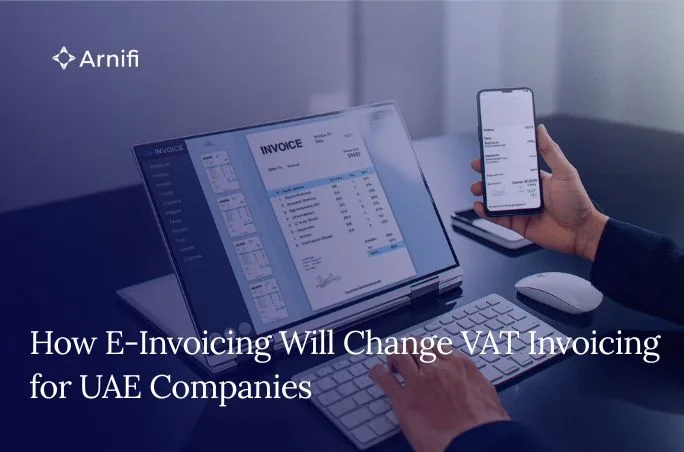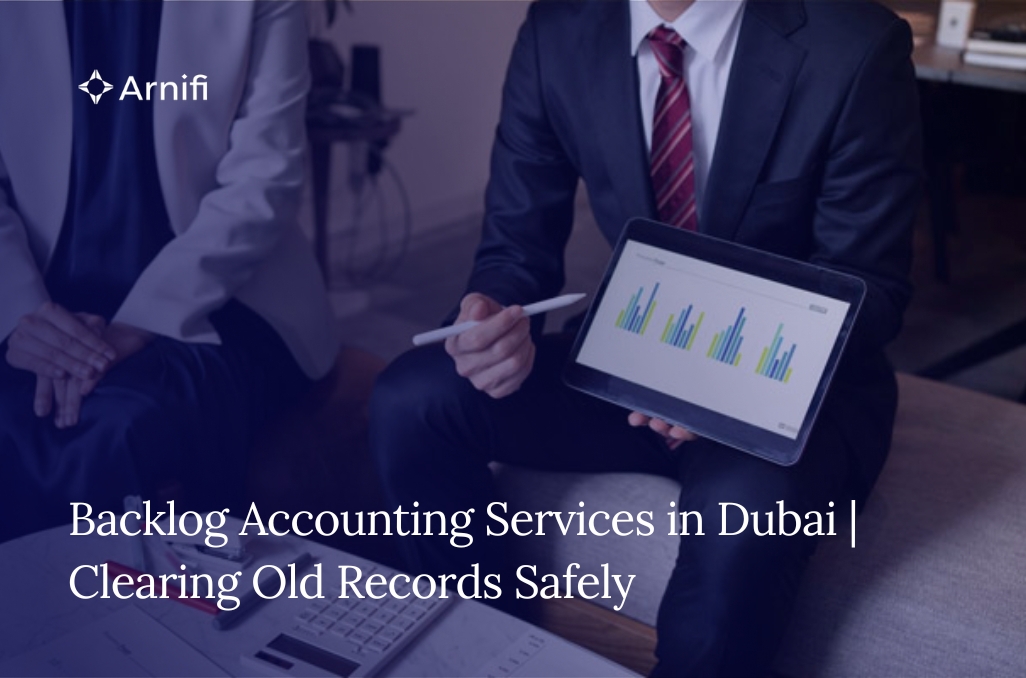How E-Invoicing Will Change VAT Invoicing for UAE Companies
by
Ishika Bhandari
Nov 22, 2025  7 MIN READ
7 MIN READ

Table of contents
The businesses in UAE are now adapting the e-invoicing system. Federal Decree-Law No. 16 of 2024 amends the VAT Law to recognise electronic invoices and create a formal electronic invoicing system. It is supported by Decree-Law No. 17 of 2024 on tax procedures.
Ministerial Decisions in 2025 set the framework. It is an officially confirmed rollout for the national Electronic Invoicing System which will begin by July 2026. The Federal Tax Authority (FTA) operates it.
This guide helps business teams understand what new rules mean, how the system will work, and which practical changes UAE companies should begin planning.
What is E-Invoicing in UAE?
The Ministry of Finance defines e-invoicing as the issuance, exchange and storage of VAT invoices in a structured electronic format through accredited channels linked to the FTA’s Electronic Invoicing System. Simple PDFs and image scans are not treated as e-invoices.
Decree-Law No. 16 of 2024 updates core VAT provisions on invoice issuance and electronic invoices. Also, it states input tax recovery so that properly issued e-invoices are valid VAT documents. Related amendments to the Tax Procedures Law adjust penalty and procedure rules to reflect digital records.
Executive Regulation amendments effective from late 2024 refine deadlines and content rules for tax invoices and simplified tax invoices, which now sit behind the e-invoicing design.
Timeline and Scope for E-Invoicing
Implementation will be phased rather than immediate. Public statements and technical notes indicate that the Electronic Invoicing System will begin with a supervised pilot and then move into mandatory phases based on annual revenue and entity type.
The key points are:
- A pilot programme for selected taxpayers begins on 1 July 2026 under Ministry of Finance and FTA supervision. Voluntary adoption is open to any VAT-registered business from the same date.
- Businesses with annual revenue of at least AED 50 million must appoint an Accredited Service Provider (ASP) by 31 July 2026. They must then go live on e-invoicing from 1 January 2027.
- Businesses below AED 50 million revenue must appoint an ASP by 31 March 2027. They must start e-invoicing from 1 July 2027.
- Government entities follow by 1 October 2027 in later phases.
What Counts as a Valid E-Invoice?
A valid e-invoice under the UAE framework is a structured data file, not a human-designed layout. The UAE has adopted a Peppol-based model using the PINT AE specification and a five-corner exchange architecture.
In practice this means:
- Invoice information is encoded in XML using the PINT AE structure rather than free text.
- Suppliers send invoices through accredited service providers or access points, which perform basic format and business validations before forwarding to buyers and the FTA.
- The FTA’s system records and may acknowledge or reject invoices based on set rules; rejected invoices are not valid for VAT purposes until corrected.
Important Advice: Over time, input tax deduction will rely on these recognised e-invoices rather than any document labelled “invoice”.
Key Milestones For Businesses
Companies can plan e-invoicing projects around the public milestones below:
- 2025: Legal framework and Ministerial Decisions in force. MoF lists pre-approved service providers and publishes technical guides.
- 1 July 2026: Pilot programme starts for selected taxpayers. Voluntary adoption available to all VAT-registered entities.
- 31 July 2026 / 1 January 2027: Large businesses (≥ AED 50 million revenue) must appoint an ASP and begin mandatory e-invoicing.
- 31 March 2027 / 1 July 2027: All VAT registered businesses must choose an ASP and start e invoicing on their deadline. Government departments will join the system later in 2027, after business timelines are already running.
Data and Format Requirements
Existing VAT rules on tax invoice content continue to apply but shift into structured fields. Article 59 of the Executive Regulations still requires supplier and customer details, TRNs, invoice date, description, consideration and VAT amounts for standard and simplified tax invoices.
The PINT AE specification mirrors these elements with dedicated tags for header information, parties, tax totals and line items, while also adding routing and control fields demanded by Peppol and the FTA.
Record-keeping obligations stay in place. VAT records, including electronic invoices and related logs, must be retained for at least five years (and longer for some real estate and capital asset records), provided that integrity and accessibility are preserved for audits.
System and Process Changes Required
To comply with e-invoicing for business in UAE, organisations will need coordinated adjustments across finance, tax and IT:
- ERP and billing systems. Enable generation of PINT AE-compliant XML, application of FTA validation rules and secure connection to accredited service providers.
- Master data quality. Cleanse customer and supplier records, especially TRNs and addresses, since invalid or missing identifiers are a frequent cause of e-invoice rejection in similar regimes.
- Workflow design. Move tax and commercial checks upstream so invoices are validated before transmission, not after dispatch of PDFs.
- VAT compliance integration. Align e-invoice data with VAT return processes, using the same dataset for filings and reconciliations instead of manual spreadsheets.
Common Implementation Risks
Experience in other e-invoicing mandates and early UAE commentary show consistent pressure points:
- Compressed timelines. Large taxpayers that delay vendor selection risk facing full implementation, testing and training inside a few months before January 2027.
- Fragmented solutions. Separate tools for billing, e-invoicing and VAT reporting can create reconciliation gaps and duplicated configuration work.
- Insufficient testing. Limited pilot runs lead to high rejection rates at go-live, affecting cash collection and supplier relationships.
- Weak change management. Staff may continue sending PDFs or manual invoices outside the system if training and governance are not explicit.
Audit Trail and Tax Governance
The new system will give the FTA near real-time visibility of B2B and B2G transaction data because invoices are validated and transmitted through accredited networks.
Internal controls should therefore extend beyond technical checks to governance and monitoring:
- Regular reconciliations between e-invoice records, VAT returns and general ledger balances.
- Reviews of rejection logs and error codes with root-cause analysis and remediation plans.
- Clear ownership for e-invoicing compliance within finance and tax, documented in policies and risk registers.
Important Advice: Handled well, e-invoicing data can strengthen broader tax risk management and support Corporate Tax and transfer pricing analytics over time.
Business Readiness Checklist
A concise readiness checklist helps management track progress:
- Confirm which UAE entities fall within the mandate and identify revenue bands and expected go-live dates.
- Decide on an e-invoicing operating model: direct Peppol connection, use of an ASP, or ERP-integrated solution.
- Map current invoice types, flows and exemptions against the planned Electronic Invoicing System scope.
- Prepare a project plan covering design, build, testing, training and governance sign-off before the relevant mandatory date.
Conclusion
E-invoicing will reshape how UAE businesses document and report taxable supplies. The legal path is now fixed, the technical model is defined and the first mandatory date for large taxpayers is less than two years away.
Wishing to adapt the latest e-invoiding system for business? Hire expert accounting and bookkeeping services in UAE from Arnifi.
We work with UAE entities that want a structured, risk-based transition instead of a late rush. Arnifi helps select or configure e-invoicing solutions, set data standards, test integration with accredited service providers and build reconciliations that link e-invoice data to VAT returns and ledgers.
For businesses that treat e-invoicing for business in UAE as part of wider finance and tax modernisation, this approach reduces operational risk and positions them well for future digital reporting reforms.
Top UAE Packages

Related Articles
Top UAE Packages



